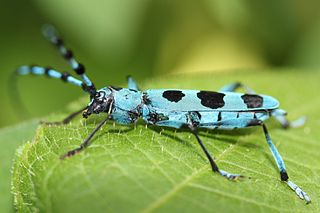
The large yellow underwing is a moth, the type species for the family Noctuidae. It is an abundant species throughout the Palearctic realm, one of the most common and most familiar moths of the region. In some years the species is highly migratory with large numbers appearing suddenly in marginal parts of the range.

Dorcasominae is a subfamily in the longhorn beetle family Cerambycidae. There are about 14 genera and more than 30 described species in Dorcasominae, found mainly in Asia and Africa. These genera are sometimes considered members of the tribe Dorcasomini, which would be the only tribe of this subfamily. This classification is in accordance with the TITAN Cerambycidae database, Catalogue of Life, and Photographic Catalog of the Cerambycidae of the Old World. It is similar to that of Bouchard et al. in "Family-group names in Coleoptera", 2011.

Achrysonini is a tribe of Long-Horned Beetles in the beetle family Cerambycidae. There are more than 20 genera and 50 described species in Achrysonini. They are found mainly in the Americas, but also in Europe, Asia, and Africa.

Poeciloxestia is a genus of longhorn beetles in the family Cerambycidae. There are more than 20 described species in Poeciloxestia, found in Central and South America.

Compsocerini is a tribe of beetles in the subfamily Cerambycinae, containing the following genera:

Eburiini is a tribe of beetles in the subfamily Cerambycinae, synonymous with the tribe Heteropsini Lacordaire, 1868, containing the following genera:

Pronuba is a genus of long-horned beetles in the family Cerambycidae. There are about five described species in Pronuba, found in Central and South America.
Heteropsini is a tribe of beetles in the subfamily Cerambycinae, synonymous with the tribe Eburiini Blanchard, 1845, containing the following genera:

Lautarus is a genus in the longhorn beetle family family Cerambycidae. This genus has a single species, Lautarus concinnus. It is known from southern Argentina and Chile.
Phantazoderus frenatus is a species of longhorn beetle in the Cerambycinae subfamily, and the only species in the genus Phantazoderus. The species was described by Léon Fairmaire and Jean-François Germain in 1864. It is known from Chile and southern Argentina. In flight, Phantazoderus frenatus is easily confused with species of Pyractomena, with which it shares coloration. Its rarity may be due to the density relationship with its model, as a remnant of Batesian mimicry.

Pronuba decora is a species of long-horned beetle in the family Cerambycidae. It is found in Argentina, Brazil, and Paraguay.
Pronuba gracilis is a species of long-horned beetle in the family Cerambycidae. It is found in Costa Rica.
Pronuba incognita is a species of long-horned beetle in the family Cerambycidae. It is found in Costa Rica, Honduras, and Panama.
Pronuba lenkoi is a species of long-horned beetle in the family Cerambycidae. It is found in Brazil and Bolivia.
Piola is a genus in the long-horned beetle family Cerambycidae. There are about six described species in Piola, found in the Neotropics.
Piola colombica is a species of long-horned beetle in the family Cerambycidae. It is found in Colombia.
Piola quiabentiae is a species of long-horned beetle in the family Cerambycidae. It known from Bolivia, Brazil, Argentina, and Paraguay.
Piola rubra is a species of long-horned beetle in the family Cerambycidae. It is known from Bolivia.
Piola unicolor is a species of Long-Horned Beetle in the beetle family Cerambycidae. It is known from Brazil.

Phosphorus virescens is a species of beetle in the family Cerambycidae. It was described by Guillaume-Antoine Olivier in 1795, originally under the genus Cerambix. It has a wide distribution throughout Africa. It is the only species in the genus Phosphorus.








